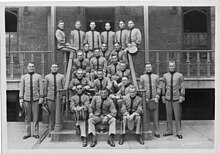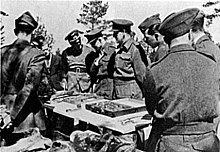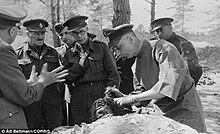| John H. Van Vliet Jr | |
|---|---|
 Van Vliet Jr circa 1952 Van Vliet Jr circa 1952 | |
| Born | (1914-11-09)November 9, 1914 Texas City, Texas |
| Died | February 5, 2000(2000-02-05) (aged 85) Sandy Springs, Georgia |
| Occupation | United States Army |
| Spouse | Miriam Samelson |
| Children | Jacqueline, Susan, Sara, and John H. Van Vliet III |
John H. "Jack" Van Vliet Jr (November 9, 1914 – February 5, 2000) was a career United States Army officer. He graduated from the United States Military Academy (U.S.M.A.) in 1937, fought in North Africa with II Corps (United States), and was captured during the Battle of Sidi Bou Zid on February 17, 1943. While a captive of the Germans, Van Vliet Jr and fellow POW Captain Donald B. Stewart were selected to attend the Katyn Commission investigation into the Polish officers found murdered in the Katyn Forest near Smolensk, Russia. Van Vliet Jr and Stewart were U.S. Registered Code Users who sent coded messages from Oflag 64 to MIS-X in Fort Hunt New Jersey which identified the Soviets as the perpetrators of the massacre. After their liberation, they testified before the United States House Select Committee to Conduct an Investigation of the Facts, Evidence, and Circumstances of the Katyn Forest Massacre about their experiences at the Katyn Commission exhumations.
Early life and education

John Huff Van Vliet Jr was born into a military family on November 9, 1914. His father, Colonel John H. Van Vliet Sr, graduated from the U.S.M.A. in 1913.
An "Army brat", Van Vliet Jr lived in multiple places including China, the Philippines, and even at West Point during the time his father was an instructor at USMA. He was graduated from Wentworth Military Academy and was appointed to the US Military Academy Class of 1937 with a Senatorial Appointment from Kansas. As a cadet, he was a member of the track team, the swimming team and the Protestant Chapel Choir.
Career
After graduation and commissioning as a Second Lieutenant of Infantry, Van Vliet Jr served at Fort Washington MD, and then with the 27th Infantry Regiment in Hawaii.
World War II

In September 1941, Van Vliet Jr was ordered to go to the United Kingdom (UK) in civilian clothes where he observed the British Army and took specialized British Army courses. He briefly returned to Fort Benning as an instructor at the Infantry School before traveling again to the UK to take command of the 3rd Battalion of the 168th Infantry Regiment (United States) (3/168th Infantry) and lead it during the Operation Torch invasion of North Africa. The 3rd/168th Infantry was a part of the Iowa National Guard which had been assigned to the 34th Infantry Division (United States) and was a component of II Corps (United States) during the 1942-43 battle for North Africa..
On February 14, 1943, Lieutenant General Heinz Ziegler launched Unternehmen Frühlingswind (Operation Spring Breeze) which started with the Battle of Sidi Bou Zid and ened with the Battle of Kasserine Pass in eastern Tunisia. Van Vliet Jr's battalion, which had been assigned to defend DJebel Ksaira, which was located between Faid Pass and Sidi Bou Zid, was surrounded on the first day of the battle. On February 16, a light aircraft dropped a message instructing the Americans to abandon DJebel Ksaira and rejoin Allied lines at Djebel Hamia 42 miles to the west. At dawn on the morning of February 17, a German armored unit surrounded Van Vliet Jr's 3rd/168th Infantry unit. A short battle ensued which resulted in the capture of approximately 800 of the 960 men in Van Vliet Jr's Battalion.
By the time Unternehmen Frühlingswind ended with the Battle of Kasserine Pass, II Corps had suffered over 300 men killed in action, 3,000 wounded, and over 4,000 men captured or missing in action. Van Vliet Jr was grouped with other captured U.S. Army officers, moved to Sfax and Tunis, and flown to Naples, Italy where he was interned at P.G. (Prigione di Guerra) 66 in Capua. On March 15, 1943, he was moved to Oflag IX/AZ in Rotenburg an der Fulda.


After the April 11, 1943 announcement of the discovery of the mass graves in the Katyn Forest, Van Vliet Jr was selected at Oflag IX/AZ along with Stewart and Lieutenant Colonel Frank Parker Stevenson to attend the International Katyn Commission exhumations in the Katyn Forest. They departed Oflag IX/AZ on May 9, 1943 and arrived in Smolensk, Russia on May 12, 1943 with a British civilian internee Frank Stroobant, British doctor Captain Stanley Gilder, and two British other ranks. The Allied POWs attended the International Katyn Commission activities on May 13, 1943, viewing many exhibits and witnessing an autopsy. After their visit to the Katyn Forest, Van Vliet Jr and Stewart returned to Berlin, Germany, and shortly thereafter to Oflag IX/AZ. Van Vliet Jr faked an illness so he could be hospitalized and thus able to participate in his first escape attempt but the Germans discovered the tunnel and the escape attempt failed.

Van Vliet Jr and Stewart were transferred to Oflag 64 in Schubin (now Szubin), Poland in June 1943 where they became integral members of the ultra secret MIS-X escape and intelligence gathering network. Van Vliet Jr assumed the role of "Big X" and was placed in charge of coordinating and approving any escape attempts. He participated in three failed escape attempts with three other POWs while at Oflag 64, The four POWs, Van Vliet Jr, 2LT William F. Higgins, 1LT Roy J. Chappell Jr, and 2LT Frank Newell Aten, were fondly referred to as "Escape Artists" by their fellow POWs. In July 1943, Van Vliet Jr and Stewart sent a coded message back to MIS-X in Fort Hunt which informed U.S. Military Intelligence in Washington D.C. that the Soviets had murdered the Polish officers found in the mass graves in the Katyn Forest. When Stewart was queried by MIS-X on March 10, 1944 to "SEND YOUR JUDGEMENT ON KATYN", both Van Vliet Jr and Stewart responded on April 9, 1944 clearly reaffirming that they believed that the Soviets murdered the Polish officers found in the mass graves in the Katyn Forest.
With the Red Army approaching Schubin from the east, the Germans evacuated nearly 1,350 POWs from Oflag 64 on foot on January 21, 1945. Van Vliet Jr and Stewart were a part of this column until February 15, 1945 when Van Vliet Jr and Stewart split up, each keeping possession of the docouments given to them by the Germans while at Katyn. Van Vliet Jr took charge of the injured POWs being shipped by rail to Stalag III-A in Luckenwalde, Germany while Stewart remained with the Oflag 64 POW column marching to Oflag XIII-B near Hammelburg, Germany. On ??? April 1945, Van Vliet Jr escaped from Stalag III-A and reached American lines on 5 May 1945 still in possession of his 1943 Katyń exhumation photos and signed travel orders to the Katyń Forest. On 6 May 1945, Van Vliet Jr spoke with General “Lightning Joe” J. Lawton Collins, Commanding General of Seventh Corps, who was a longtime friend of the Van Vliet family, and made his first official non-MIS-X Katyń massacre report since being liberated to a regular U.S. Army Intelligence G-2 officer
Van Vliet Jr was ordered to report to Paris where he made his first deposition about his experiences at the 1943 International Katyn Commission at the European Theater of Operations, United States Army Headquarters War Crimes Branch of the Judge Adjutant Section in Paris, France. He testified that he believed the Soviets murdered the Polish officers who were found in the Katyn Forest mass graves. The report later became known as the Van Vliet Paris Report. Van Vliet Jr then traveled to Washington DC where he reported to General Clayton Lawrence Bissell on May 22, 1945 and dictated an oral statement about his visit to the Katyn Forest. The completed transcribed testimony later became known as the 1945 Van Vliet Report and was immediately lost. Bissell issued a written order instructing Van Vliet Jr which stated "it is directed that you neither mention nor discuss this matter with anyone in or out of the service without specific approval in writing from the War Department". When Van Vliet Jr informed Stewart of Bissell's written instructions, Stewart abided by the order as well.
After World War II
After WWII, Van Vliet Jr remained silent about his 1943 visit to the Katyn Forest. Congressional members began taking an interest into the Katyn massacre during the late 1940s. On April 26, 1950, Van Vliet Jr was ordered by Major General F. L. Parks to recreate the missing 1945 Van Vliet Report. Van Vliet Jr complied and wrote a 6 page report dated May 11, 1950 which later became known as the 1950 Van Vliet Report.
On February 4, 1952, Van Vliet Jr testified before the United States House Select Committee to Conduct an Investigation of the Facts, Evidence, and Circumstances of the Katyn Forest Massacre which included Michigan Congressman Dondero. His testimony lasted 2 hours and 30 minutes, and he provided the House committee detailed descriptions of his selection by the Germans to attend the International Katyn Commission's Katyn Forest exhumations, and his personal observations while he was in the Katyn Forest. In neither of their open testimonies before the House committee did Van Vliet Jr or Stewart ever mention that they had sent coded messages to MIS-X while still a POW in Oflag 64 about their convictions of the Soviet guilt for the Katyn massacre. Both men continued to respect Bissell's nondisclorsure instructions until Van Vliet Jr was released from Bissell's instructions in 1962 and Stewart was released in 1968 after his retirement from the U.S. Army.
Van Vliet Jr continued to serve as an Infantry officer. He deployed to the Korean War as Executive Officer of the 23d Infantry Regiment, 2nd Infantry Division. Later he served in Japan where he participated in establishing the Japanese Army school system. Two regimental commands followed (one training and one Airborne Infantry) as well as an assignment in France as part of the Communications Zone. He retired in 1959 as a Colonel.
After retirement from the army, Van Vliet Jr was the Village Manager for Ardlsey, New York. He later moved to Florida where he became the Assistant Parks Director for Pinellas County.
In 1980, Roy L. Towers interviewed Van Vliet Jr and Stewart and produced a documentary for a Master's degree thesis in History. Towers' thesis was entitled The Case of the Missing Officers: The Katyn Forest Massacre, and contains the only known video interviews that Van Vliet Jr and Stewart gave about the Katyn massacre. It was released in June 1984.
In an April 8, 2015 ceremony held in Warsaw, Poland 75 years after the announcement of the discovery of the graves in the Katyn Forest, President Bronisław Komorowski posthumously awarded Van Vliet Jr and Stewart the Officers Cross of the Order of Merit of the Republic of Poland. They are the only two U.S. Army officers to have received this medal.
On April 11, 2015, a monument honoring Van Vliet Jr and Stewart was unveiled at the former Oflag 64 site in Szubin Poland. The monumnet acknowledged the code letters that Van Vliet Jr and Stewart sent to U.S. Military Intelligence in 1943 and 1944 which stated that they believed the Soviets murdered the Polish officers who were found in the Katyn Forest.
Marriage and children
While attending a course at Yale, Van Vliet Jr met Miriam Samelson Barton whose husband had been killed testing planes during WWII. They were married on January 12, 1947, and Van Vliet Jr adopted Jacqueline Lee Barton Van Vliet. They had three children together:
Death
Van Vliet Jr died on 5 February 2000 in Sandy Springs, Georgia, of multiple age-related factors. He and his wife, Miriam, are buried in the cemetery at the United States Military Academy.
Philosophical and/or political views
Echoing the message from his own father, Van Vliet Jr believed "if it isn't right, it is wrong". Honor is to be upheld, duty is to be fulfilled, and fun is to be found and enjoyed. Live life well.
Recognition

| ||||||||||||||||||||||

  | ||||||||||||||||||||||
Media
- Im Wald von Katyn is a 1943 documentary about the Katyn Commission investigation produced by the Government of Nazi Germany.
- Oflag 64: A P.O.W. Odyssey is a TV documentary made by PBS in 2000.
See also
References
- Hearings Before the Select Committee to Conduct an Investigation of the Facts, Evidence, and Circumstances of the Katyn Forest Massacre (First ed.). USA: The United States Government Printing Office. October 11, 1951. pp. 4–6.
- Fromm, Phil (2015). Evasion and Escape Devices: Produced by MI9, MIS-X and SOE in World War II (First ed.). Atgen, Pennsylvania USA: Schiffer Publishing, Ltd. pp. 29–33. ISBN 978-0-7643-4839-6.
- Hearings Before the Select Committee to Conduct an Investigation of the Facts, Evidence, and Circumstances of the Katyn Forest Massacre (First ed.). USA: The United States Government Printing Office. October 11, 1951. pp. 1–74.
- Atkinson, Rick (2002). An Army at Dawn: The War in North Africa, 1942-1943 (First ed.). New York, New York: Henry Holt and Company, LLC. pp. 355–357, & 389. ISBN 978-0-8050-6288-5.
- Holder, Howard Randolph (1994). Escape to Russia (First ed.). Athens, Georgia: Iberian Publishing Company. pp. 1–12. ISBN 0-935931-87-2.
- Meltesen, Clarence R. (April 1990). Roads to Liberation from Oflag 64 (Second ed.). USA: Clarence R. Meltesen. pp. 230–231. ISBN 0-9627005-3-3.
- Hearings Before the Select Committee to Conduct an Investigation of the Facts, Evidence, and Circumstances of the Katyn Forest Massacre (First ed.). USA: The United States Government Printing Office. October 11, 1951. pp. 24–25.
- Hearings Before the Select Committee to Conduct an Investigation of the Facts, Evidence, and Circumstances of the Katyn Forest Massacre. USA: The United States Government Printing Office. February 4, 1952. pp. 47–50.
- Hearings Before the Select Committee to Conduct an Investigation of the Facts, Evidence, and Circumstances of the Katyn Forest Massacre. USA: The United States Government Printing Office. February 4, 1952. p. 51.
- Hearings Before the Select Committee to Conduct an Investigation of the Facts, Evidence, and Circumstances of the Katyn Forest Massacre. USA: The United States Government Printing Office. February 4, 1952. pp. 31–74.
Further reading
- United States Congress: "The Katyn Forest Massacre: Hearings before the Select Committee to Conduct an Investigation of the Facts, Evidence and Circumstances of the Katyn Forest Massacre". United States Government Printing Office, 1952. (Volume 2).
- Zawodny, J. K.:"Death in the Forest: The Story of the Katyn Forest Massacre". University of Notre Dame Press, 1962. (Page 179).
- Van Vliet JR, COL John H.: "The Massacre at Katyn". Argosy Magazine, December 1962. (Pages 20 & 116).
- Wittlin, Thaddeus: "Time Stopped at 6:30: The Untold Story of the Katyn Massacre".The Bobbs-Merrill Company, Inc., 1965. (Page266, 290, 296, 299, 3, & 303).
- Fitzgibbon, Louis: "Katyn: A Crime Without Punishment". Charles Scribner's Sons, 1971. (Page 118, Photo No. 31).
- Meltesen, Clarence R.: "Roads to Liberation from Oflag 64". San Francisco: Oflag 64 Press 2nd Edition 1990. (Pages 238 & 272).
- Diggs, Frank J.: "Americans Behind the Barbed Wire, World War II: Inside a German Prison Camp". Arlington, VA: Vandamere Press, 2000. (Page 32).
- Maresch, Eugenia: "Katyn 1940: The Documentary Evidence of the West's Betrayal". Spellmount, 2010. (Pages 75, 105, & 223).
- Paul, Allen. "Katyń: Stalin’s Massacre and the Triumph of Truth". DeKalb, Illinois: Northern Illinois University Press updated pbk. Ed., 2010. (Pages 236 & 312).
- Dando-Collins, Stephen: "The Big Break: The Greatest American WWII POW Escape Story Never Told". St. Martin's Press, 2017. (Pages 96 & 187).
- Wasilewski, Witold: "Mord W Lesie Katynskim: Przesluchania przed amerikanski komisja Maddena w latach 1951-1952 Tom 1". Druk i oprawa, 2017. (Pages 161-190).
- Shultz, Duane: Patton's Last Gamble: The Disastrous Raid on POW Camp Hammelburg in World War II. Stackpole Books, 2018. (Pages 101 & 121).
- Charles River Editors: "The Katyn Forest Massacre: The History of the Notorius Slaughter of Polish Prisoners by the Soviets during World War II". Charles River Editors, 2019. (Chapter 6, Pages 8–10).
- Stewart, David A.: "Katyn Forest Massacre: A Selection of Declassified U.S. Government Documents". Wydawnictwo Graf_ika, 2023. (Volume I).
External links
- Battle Analysis Methodology With Kasserine Pass Battle Analysis
- Muzeum Katyńskie
- Oflag 64 Remembered
- The Oflag 64 Record blog
- Polish-American Foundation for the Commemoration of POW Camps in Szubin